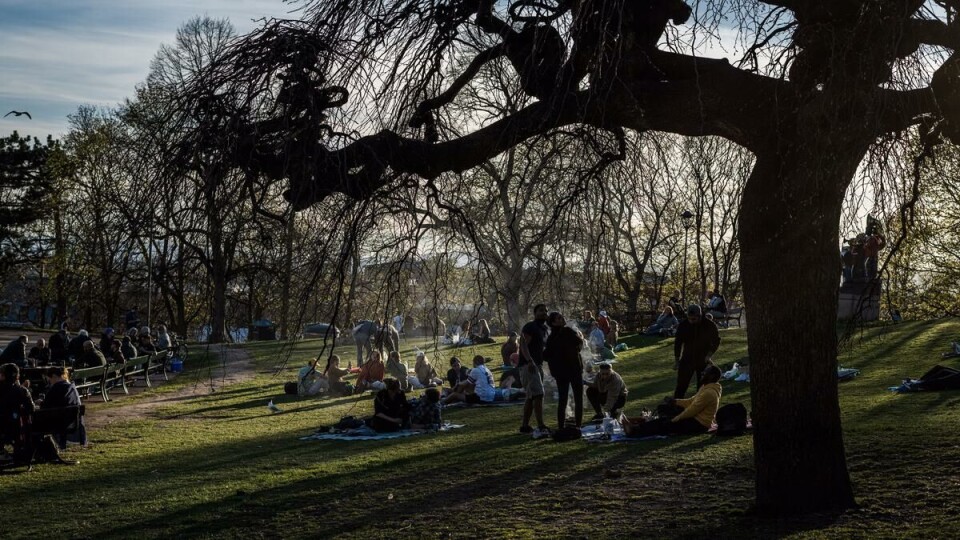Gunnar’s Daughter:

Experience Oslo Through the Lens of a (Modern) Classic
«Veterlide and Ljot stood in the fore-part of the ship, looking out over the land. It was then covered with thick forest; along the banks of the river were farms, but they were not many and most were small.»
For international students arriving in Norway in 2021, this description of Oslo might feel unrecognizable. None, I assume, traveled here by longship, and the highrises of the Barcode one sees from the train as it pulls into Oslo S leave no trace of the scattered farmland that used to curve along the fjord.
The Plot, and the Presence of the Past
The above excerpt is from Sigrid Undset’s first historical novel, Gunnar’s Daughter (called «Fortellingen om Viga-Ljot og Vigdis in Norwegian») which was first published in 1909. The tale follows Ljot, from Iceland, and Vigdis, from Norway as they meet in eleventh-century Oslo and … almost fall in love. What begins in the rhythm of a fairytale, with a young, remarkable warrior wooing a fair maiden, quickly becomes a story of trauma and revenge, as the forces of individual desires are brought to extreme and bloody conclusions within the strict social codes surrounding family, friendship, and sexuality.
The novel is quite short, reaching only 152 pages in the Penguin Classics edition. Though the writing style Undset uses is inspired by the sparse prose characteristic of Icelandic saga, she eschews the narrative detours and detailed genealogical descriptions typical of the genre for a more accessible and cohesive reading experience. Undset won the Nobel Prize in Literature in 1928 for another historical novel, Kristin Lavransdatter, a Bible-length tome dealing with similar issues in medieval Norwegian society, and also partially set in Oslo.
However, a busy everyday life in a new city might make reading a thousand pages impossible during the length of an exchange. Gunnar’s Daughter, though less well-known than Kristin Lavransdatter, is still a masterpiece in its own right and provides a taste of Undset’s developing style and worldview.
Although Gunnar’s Daughter is set nearly a thousand years in the past, the story we encounter continues to resonate in our own time. While violent family vendettas, outlawry, and horse-fighting are no longer integral parts of Norwegian society, tensions between different generations, lost love, betrayed trust, and loneliness are universals that transcend time and place.
The central throughline of the novel, an exploration of sexual assault and its aftermath, reflects our own society’s discourse around the topic, and shows us how little has changed: the blaming of the victim, sympathy with the perpetrator, and a lack of justice. In subverting the tropes of medieval romance, Undset undermines the myth of progress, the idea that civilization has advanced far beyond the «backwards» Middle Ages. The past, instead of being conceived as a hazy, foreign land, now becomes a mirror.
Retrace Vigdis’ Steps
Though the central problems of our humanity have varied little since the period encapsulated by Gunnar’s Daughter, Oslo, on the other hand, has changed quite a bit. Now the booming capital of a wealthy nation, it is a far cry from the network of small farms one finds in the pages of the novel. However, there are still several places in the city that bear the traces of the world in which Sigrid Undset imagines Vigdis and Ljot, and some you may have been to already.
The «thick forest» Veterlide and Ljot see from their ship is, after all, only a larger version of Nordmarka, whose trees continue to loom over the northern ridge of the city today. Here’s a list of all the places in Oslo that feature in Gunnar’s Daughter, along with short explanations of their relevance to the novel. After reading the book, or even while reading it, you might take yourself on a Gunnar’s Daughter tour of Oslo. (Spoilers ahead!)
Vøienvolden gård
This is Vigidis’ home, called Vadin in the novel, and as such it is one of the most important settings in the text. The current buildings date back to the eighteenth century, and have been preserved by the National Trust of Norway. The grounds are open to the public, which is a perfect opportunity for an idyllic walk and picnic, if the weather allows.
St. Hanshaugen Park
In the novel, this well-known Oslo landmark is only referred to as «the high place». However, based on its proximity to Vøienvolden gård, which is supposed to be a relatively short walking distance away, St. Hanshaugen is my best guess for the modern identity of «the high place». This is where Vigdis and Ljot meet during their courtship, and where that courtship comes to its horrific end.

Maridalsvannet
In one of her defining moments as a character, Vigdis flees over this frozen lake after her enemies kill her father and burn Vadin to the ground. Her tenacity and endurance as she protects herself and her young son from wolves and the frigid winter cold is nothing short of awe-inspiring.
Margaretakirken
To the north of Maridalsvannet are situated the ruins of this medieval church, which Undset gives as the final resting place of her protagonist, Vigdis. Every summer the church hosts Maridalsspillet, a theatrical production related to the history of the area. The past two years have led the play to be cancelled on account of the pandemic, but Oslo can look forward to Svartedauen (The Black Death) in 2022. Who knows, you might find Vigdis’ ghost among the audience.
Berg gård
Like Vøienvolden gård, Berg is no longer an operational farm. Nonetheless, the farmhouse, which was erected in the latter half of the eighteenth century, still stands today. In Gunnar’s Daughter, Vigdis owns this farm, and lives out her days there after the death of Ljot. The farm is located near Ullevål stadion, and lends its name to the metro stop on Line 5 towards Sognavann. It is also the home to five burial mounds.
Disen gård
This farm, located in the district of Grefsen today, is the home of Vigdis’ close ally and suitor, Kaare. The current farmhouse was built and refurbished throughout the eighteen-hundreds, but, according to the farm’s webpage, it has been an agricultural and religious hub since the Iron Age.
Grimelund gård
The sons of Arne, the enemies first of Gunnar and then of his daughter, Vigdis, hail from this farmstead. In contrast to the sordid mythology Undset creates around the farm, one of the buildings has now been repurposed as a kindergarten, where children can be seen learning and playing throughout the week. The barn, the stabbur, and the smithy still stand on the grounds today, though of course not in their original forms.
Gamle Aker kirke
In the world of Gunnar’s Daughter, Undset credits the building of this church to Vigdis, who buries Ljot there at the close of the novel. Although Gamle Aker was likely built by King Olaf III, and not a woman like Vigdis, the austere romanesque architecture and the solemnity of the cemetery are apt monuments to all Vigdis managed to build, as well as all that she lost.
If you like books that hurt — but in a thought-provoking way — I cannot recommend Gunnar’s Daughter enough. I wish you the best of luck as you embark on your own saga through Oslo, with Sigrid Undset and her intractable heroine by your side.






























